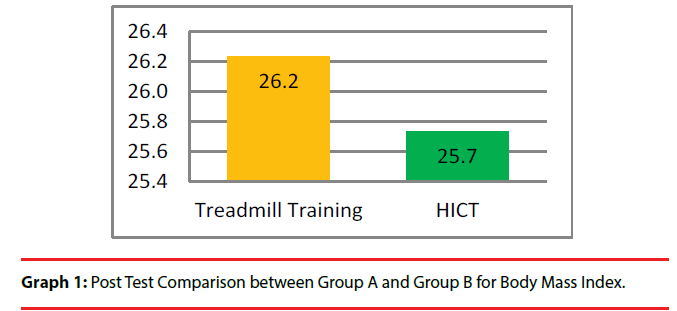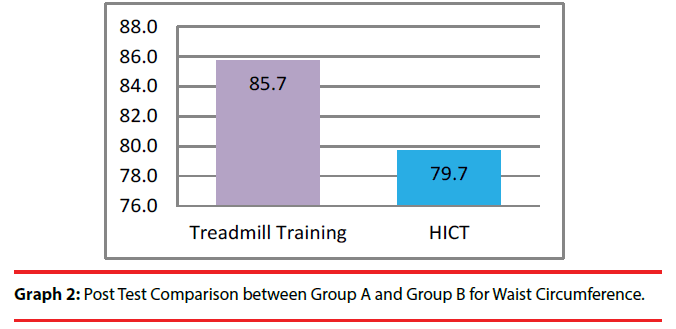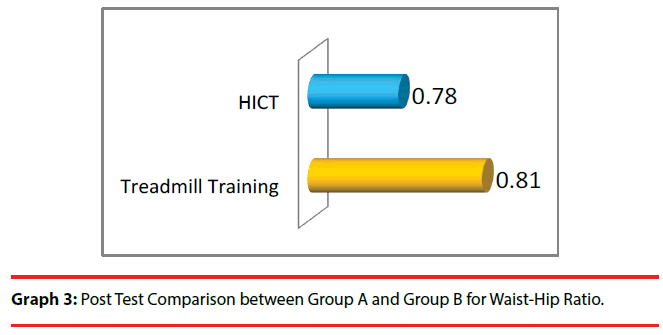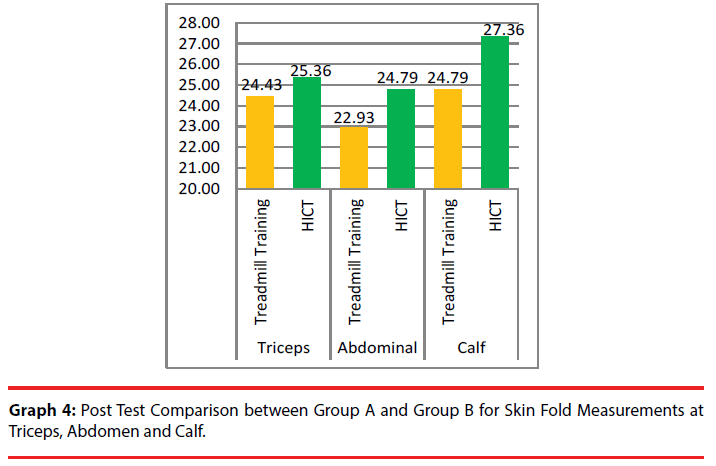Effect of treadmill training versus high intensity circuit training in overweight individuals
- Corresponding Author:
- Malarvizhi D
Associate Professor
College of Physiotherapy
Kattankulathur campus, SRM University
SRM Nagar, Kattankulathur - 603 203
Kancheepuram District, Tamil Nadu, India
Tel: 044-47432720; 044-2745-6729,
email: malarvizhi.d@ ktr.srmuniv.ac.in
Abstract
BACKGROUND: Previous studies have shown significant effects of aerobic exercise such as treadmill training in overweight individuals. High-intensity circuit training now has become a popular way to exercise, boost metabolism and increase strength. OBJECTIVE: To compare the effect of treadmill training versus high-intensity circuit training in overweight individuals.
STUDY DESIGN: Quasi experimental study design.
PROCEDURE: 28 subjects, age group 17-25 years of both male and female. 14 subjects in the Group A underwent treadmill training with pre and post-test and 14 subjects in Group B underwent high-intensity circuit training with pre and post-test.
OUTCOME MEASURE: Body mass index, waist circumference, waist-hip ratio and skinfold measurements at triceps, abdominal and calf respectively. RESULTS: Statistical analysis was showed significant improvement within the groups and no significant difference between the groups.
CONCLUSION: Treadmill training and high-intensity circuit training were both equally effective in the management of overweight individuals.
Keywords
Overweight, Treadmill training, High-intensity circuit training
Introduction
The term “overweight” refers to having more body fat than what is optimally healthy for a certain height. This is a medical condition in which excess body fat has accumulated to the extent that it may have a deteriorating effect on health [1].
Overweight can lead to obesity which is a leading preventable cause of death and is on the rise among adults, adolescents and children including populations living in developing countries. Excessive body weight is associated with various diseases, particularly cardiovascular diseases, type 2 diabetes mellitus, obstructive sleep apnoea, and certain types of cancer, osteoarthritis and asthma [2].
Excessive body weight is caused by a combination of excessive food energy intake and a lack of physical activity, increasing rates of overweight individuals at a societal level are felt to be due to an easily accessible and palatable diet [3]. A sedentary lifestyle plays a significant role in weight gain. Worldwide there has been a large shift towards less physically demanding work and insufficient exercise. This is primarily due to an increased use of transportation (automobiles) and a greater prevalence of less demanding physical work technology at home (use of remotes and other wireless technology [3].
Body Mass Index has traditionally been the chosen indicator by which we can measure body size and composition, and to diagnose underweight and overweight. However, alternative measures that reflect abdominal adiposity, such as waist circumference and waist–hip ratio have been suggested as being superior to Body Mass Index in predicting cardiovascular disease risk [4].
People are generally considered obese when their body mass index (BMI), is over 30 kg/m2, with the range 25–30 kg/m2 defined as overweight [4].
Overweight and obesity are mostly preventable through a combination of social changes and personal choices like implementation of performing exercises regularly.
Aerobic exercise is physical exercise that ranges from low to high intensity. Aerobic literally means “relating to, involving, or requiring free oxygen”, and refers to the use of oxygen to adequately meet energy demands during exercise [5]. Treadmill activity may not only increase aerobic capacity but may increase lower limb strength as well. Treadmill training is not usually thought as a strength training activity but can be effective in this regard if one has been accustomed to do lower body weight training [6].
Circuit training consists of series of resistance training exercises that boost metabolism and increase strength and are performed in succession with minimal rest between exercises. The circuit training program can vary depending on the goals of the program.
Treadmill training and circuit training were two methods of aerobic training .Many studies were available to find the effectiveness of above methods separately in normal Body mass Index persons. So the purpose of the study was to compare the two forms of aerobic training methods, treadmill training versus circuit training in overweight individuals.
Methodology
Study design was quasi experimental and study type was comparative. Sampling method used was convenient sampling and the sample size was 28 subjects. Inclusion criteria for selecting subjects were individuals with body mass index ranging from 25-29.9 kg/m2, both male and females aged 17-25 years. Exclusion criteria for subjects were any neurological conditions, genetic disorders, unstable heart conditions, liver problems, kidney problems, severe musculoskeletal problems, metabolic disorders and hormonal problems. Study duration was 6 weeks. From Fitness studio, Urapakam, Chennai fourty two overweight individuals screened, among that twenty-eight overweight individuals with body mass index (25.0-29.9 kg/ m2) were examined and included in the study based on the inclusion and exclusion criteria .Institutional Ethical Committee approval obtained and the consent of the individuals with prior permission was taken before starting the study. Participants were assigned to two groups through convenient sampling. The purpose of the study and the programs used were explained to them thoroughly. Group-A Fourteen overweight individuals received treadmill training exercise program. Group-B Fourteen overweight individuals received a highintensity circuit training program. Outcome measures were captured at baseline and at a 6 weeks follow-up. Instrumentation and tools used for treatment: Treadmill electronic device – Johnson Treadmill, Model: T7000 PRO used for warming up for group (A), group (B) and also for treadmill training program of group (A). The treadmill training program for group (A) was estimated maximum heart rate was calculated using the formula; 220 - Age. Treadmill Training Program consisted of uninterrupted walking 4 times a week for 6 weeks. Flexibility exercises were done by the participants for warm-up and cool-down. The duration of the sessions were 30 minutes at the beginning and progressively increased to 45 minutes. The initial intensity of exercise corresponded to 60% of maximum heart rate and increased to 75% of maximum heart rate reserve.
The high-intensity circuit training program for group (B) was a series of exercises performed for 30 seconds, with 10 seconds of transition time between bouts. Total time for the entire circuit workout was approximately 7 minutes. Exercises used in the circuit were jumping jacks, wall-sit, push-up, abdominal crunch, step-up, squat, triceps-dip, plank, high knees, lunge, side plank.
Waist-Hip Ratio was calculated as, waist circumference divided by hip circumference. To measure the Waist circumference, locate the upper hip bone and the top of the right iliac crest. Place a measuring tape in a horizontal place around the abdomen at the level of iliac crest. Before reading the tape measure, ensure that the tape is snug, but does not compress the skin, and is parallel to the floor. Hip circumference is measured with the subject standing erect and feet together, a horizontal measure is taken at the maximal circumference of buttocks.
Results
According to Table 1, the mean difference between the post-test values of body mass index between group A and group B was 0.5. The mean difference between the post-test values of waist circumference between group A and group B was 6. The mean difference between the post-test values of waist-hip ratio between group A and group B was 0.03. Since the p value is more than 0.05, 95% confidence interval for all the parameters, we accept the null hypothesis. Hence therefore when compared, there was no significant difference between treadmill training and high intensity circuit training in the given outcome parameters among the sampled overweight individuals.
| Levene's Test for Equality of Variances | t-test for Equality of Means | |||||||||
|---|---|---|---|---|---|---|---|---|---|---|
| F | Sig. | t | df | Sig. (2-tailed) p value | Mean Difference | Std. Error Difference | 95% Confidence Interval of the Difference | |||
| Lower | Upper | |||||||||
| BMI | Equal variances assumed | 3.508 | 0.072 | 1.087 | 26 | 0.287 | 0.5 | 0.459 | -0.445 | 1.4438 |
| Equal variances not assumed | 1.087 | 23.34 | 0.288 | 0.5 | 0.459 | -0.45 | 1.449 | |||
| WC | Equal variances assumed | 13.85 | 0.001 | 1.561 | 26 | 0.131 | 6 | 3.844 | -1.902 | 13.902 |
| Equal variances not assumed | 1.561 | 22.62 | 0.132 | 6 | 3.844 | -1.96 | 13.96 | |||
| WHR | Equal variances assumed | 1.878 | 0.182 | 0.965 | 26 | 0.343 | 0.03 | 0.035 | -0.038 | 0.1051 |
| Equal variances not assumed | 0.965 | 25.63 | 0.344 | 0.03 | 0.035 | -0.038 | 0.1051 | |||
Table 1: Post Test Comparison between Group A and Group B for Body Mass Index, Waist Circumference and Waist-Hip Ratio.
According to Graph 1, there was no statistical significance in post-test comparison of body mass index in overweight individuals among group A and group B who underwent training programs for six weeks.
According to Graph 2, there was no statistical significance in post-test comparison of waist circumference in overweight individuals among group A and group B who underwent training programs for six weeks.
According to Graph 3, there was no statistical significance in post-test comparison of waist-hip ratio in overweight individuals among group A and group B who underwent training programs for six weeks.
According to Table 2, the mean difference between the post-test values of triceps skinfold measurements between group A and group B was 0.566.
| Levene's Test for Equality of Variances | t-test for Equality of Means | |||||||||
|---|---|---|---|---|---|---|---|---|---|---|
| F | Sig. | t | df | Sig. (2-tailed) p value | Mean Difference | Std. Error Difference | 95% Confidence Interval of the Difference | |||
| Lower | Upper | |||||||||
| Triceps | Equal variances assumed | 0.827 | 0.37 | -0.581 | 26 | 0.566 | -0.93 | 1.598 | -4.212 | 2.356 |
| Equal variances not assumed | -0.581 | 24.33 | 0.566 | -0.93 | 1.598 | -4.223 | 2.367 | |||
| Abdominal | Equal variances assumed | 0.004 | 0.95 | -1.087 | 26 | 0.287 | -1.86 | 1.709 | -5.369 | 1.655 |
| Equal variances not assumed | -1.087 | 26 | 0.287 | -1.86 | 1.709 | -5.369 | 1.655 | |||
| Calf | Equal variances assumed | 0.199 | 0.65 | -1.219 | 26 | 0.234 | -2.57 | 2.109 | -6.906 | 1.764 |
| Equal variances not assumed | -1.219 | 24.68 | 0.234 | -2.57 | 2.109 | -6.918 | 1.775 | |||
Table 2: Post Test Comparison between Group A and Group B for Skinfold Measurements at Triceps, Abdomen and Calf.
The mean difference between the post-test values of abdominal skinfold measurements between group A and group B was 0.287. The mean difference between the post-test values of calf skinfold measurements between group A and group B was 0.234. Since the p value is more than 0.05 at 95% confidence interval for all the parameters, we accept the null hypothesis. Hence therefore when compared, there was no significant difference between treadmill training and high intensity circuit training in the given outcome parameters among the sampled overweight individuals.
According to Graph 4, there was no statistical significance in post-test comparison of skinfold measurements at triceps, abdominal and calf respectively in overweight individuals among group A and group B who underwent the training programs for six weeks.
Discussion
This study aimed to compare the effects between treadmill training program and highintensity circuit training program on overweight individuals.
All individuals were evaluated by body mass index, waist circumference, waist-hip ratio and skinfold measurements at triceps, abdominal and calf areas before and after 6 successive weeks of the training programs for both groups.
Significant results were seen in group A where the individuals underwent treadmill training. There was a marked reduction in the body mass index, waist circumference, waist-hip ratio and skinfold measurements at triceps, abdominal and calf.
The study results come in agreement with Sothern, who demonstrated that treadmill training can be effective at lowering Body Mass Index, body fat and weight.
During exercise, the action of lipolysis occurs, which is the action of breaking down fat and this is how fat burns.
Treadmill is one of the best cardiovascular workouts because they encourage the working of the entire body. They offer a free range movement that involves the work of the muscles, tones muscles and burns calories to help lose fat throughout the body. Treadmills offer a variety of speed settings that helps one personalise his/her workout. Using a treadmill can help one lose weight by burning hundreds of calories each time he/she exercised. Like all aerobic exercises, the number of calories one burned depended on how long and intense the exercise [7,8].
Significant results were seen in group B where the individuals underwent high-intensity circuit training. There was a marked reduction in the body mass index, waist circumference, waisthip ratio and skinfold measurement at triceps abdominal and calf.
High-intensity circuit training, is a training technique in which an individual gives all-out, one hundred percent effort through quick, intense bursts of exercise, followed by short periods of recovery. This type of training gets and keeps the heart rate up and burns fatter in less time. Performing high-intensity exercises results in the increase in body temperature which occurs during exercise thereby increasing the body’s metabolism. All of this plays a role in the fat burning process.
High-intensity circuit training workouts generally use only one’s body weight. These workouts result in optimal muscle building due to the increased work of muscles along with fat loss and increased calorie burn [9].
According to Brett Kilka [10], the below mentioned exercises showed that high-intensity circuit training seems to be an efficient means of exercise to help decrease body fat, improve insulin sensitivity, and improve VO2 max and muscular fitness.
The high-intensity circuit training program used in this study was a series of eleven exercises that focused on the body as a whole. Certain exercises stressed on the development of certain parts of the body. Jumping jacks, step-up and high knees focused mainly on the total body. Push-up and triceps-dip stressed on the improvement of the upper body by working the muscles in these areas. Abdominal crunch, plank and side planks works on the core muscles on the body. Wall-sit, squat and lunge focused on the development of the lower body [11].
In this present study, there was no significant difference between group A (treadmill training) and group B (high-intensity circuit training) because the long-term effects of each of the training programs were not analysed. Therefore, both training programs were equally effective in the management of overweight individuals. Limitations for this study were, small sample size, proper diet plan was not monitored, the subjects were only advised to reduce the dietary intake, calorie intake was not quantified and Rate of Perceived Exertion (RPE) also not considered. The recommendations for further studies are to include cardiovascular function as an outcome measure, include obese individuals and sports persons in the study. Longitudinal studies can also be done.
Conclusion
This study revealed that, treadmill training versus high-intensity circuit training showed improvement in the reduction of body mass index, waist circumference, waist-hip ratio, skinfold measurement at triceps, abdominal and calf respectively in the overweight individuals. Both treadmill training and high-intensity circuit training produced similar effects in overweight individuals for the duration on six weeks. The statistical data analysis suggested that these two programs were equally effective in the management of individuals who were overweight.
References
- "Obesity and overweight Fact sheet", January 2015, World Health Organization,Retrieved 2 February 2016.
- Haslam DW, James WP.Obesity. Lancet 366 (9492), 1197-1209 (2005).
- Lau DC, Douketis JD, Morrison KM, et al.Canadian clinical practice guidelines on the management and prevention of obesity in adults and children summary.CMAJ(2007).
- BMI Classification. Global Database on Body Mass Index. World Health Organization. (2006) Retrieved July 27, 2012.
- McArdleWD,KatchFI,KatchVL.Essentials of exercise physiology.Lippincott Williams & Wilkins(2006).
- Singh MF. Exercise, Nutrition and the Older Woman: Wellness for Women over Fifty. Science(2000).
- KilkaB, Jordan BS, Chris MS, et al.“High-Intensity Circuit Training Using Body Weight”,ACSM. Health. Fit. J(2013).
- OktayC, Ismet CG.Evaluation of effects pilates mat exercise program on some fitness parameters and weight loss of middle aged perimenopausal woman.J Physical Education Sports Sci4 (4), 123-136 (2012).
- Tremblay A, Simoneau JA, Bouchard C. Impact of exercise intensity on body fatness and skeletal muscle metabolism. Metabolism43 (7), 144-150 (1994).
- Brett K. High-intensity circuit training using body weight: maximum results with minimal investment ACSM. Health. Fit. J17 (3), 8-13 (2013).
- Salazar-Martinez E, Allen B, Fernandez-Ortega C. Obesity and overweight status among adolescents from Mexico and Egypt. Arch. Med. Res37 (4), 535-542 (2006).



